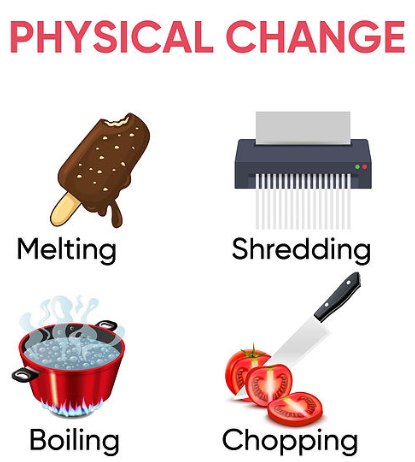Understanding the differences between physical and chemical changes is the basics in the study of chemistry. These two types of transformations describe how substances can change in terms of their composition, structure, or appearance. Physical changes involve changes that do not result in the formation of new substances, such as changes in state (like melting or freezing) or alterations in shape or size.
In contrast, chemical changes occur when substances undergo reactions that result in the formation of entirely new substances with different chemical compositions. These changes are often irreversible and involve the breaking and forming of chemical bonds.
Physical Change:
Definition: A physical change alters the physical state or appearance of a substance without changing its chemical composition. In other words, the substance remains the same at the molecular level.
Examples:
- Change in State: Melting of ice into water and freezing of water into ice are physical changes because the chemical composition of water (H₂O) remains unchanged.
- Changes in Shape or Size: Cutting paper, crushing a can, or breaking glass are physical changes because they do not alter the fundamental nature of the material.
Characteristics:
- Reversible: Physical changes can often be reversed by reversing the process that caused them (e.g., melting and freezing).
- No New Substance: No new substances are formed during a physical change.

Chemical Change:
Definition: A chemical change (chemical reaction) involves the transformation of one or more substances into new substances with different chemical compositions. Bonds between atoms are broken and new bonds are formed.
Examples:
- Combustion: Burning of wood, paper, or fuels like methane results in the formation of new substances (e.g., carbon dioxide and water).
- Rusting of Iron: When iron reacts with oxygen and water, it forms iron oxide (rust), which is a different substance from the original iron.
Characteristics:
- Irreversible: Chemical changes are typically irreversible under normal conditions.
- Formation of New Substances: New substances with different properties are formed as a result of chemical reactions.

Key Differences:
- Nature of Change: Physical changes affect the physical appearance or state of matter, while chemical changes alter the chemical composition.
- Reversibility: Physical changes are often reversible, while chemical changes are usually irreversible.
- Formation of New Substances: Chemical changes result in the formation of new substances, whereas physical changes do not.
Understanding the distinction between physical and chemical changes is fundamental in chemistry, as it helps explain how matter behaves under different conditions and interactions.
Related:
Comments
All Comments (0)
Join the conversation